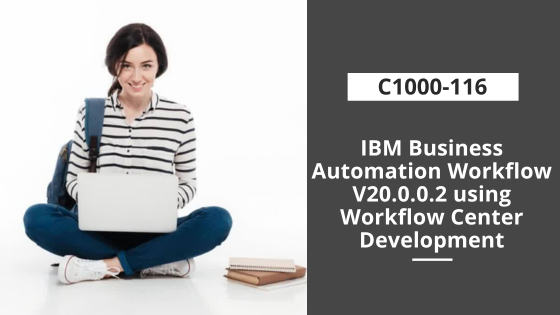Full Name: IBM Business Automation Workflow V20.0.0.2 using Workflow Center Development
Exam Code: C1000-116
Certification Overview
This intermediate level certification is intended for BAW Developers who lead and contribute to the delivery of complex process and case applications. These BAW developers implement high quality process-driven and case-driven business solutions using IBM Business Automation Workflow v20.0.0.2. This exam does not include IBM Integration Designer, Filenet P8 Process Designer or Business Automation Studio application service features.
These BAW developers are expected to be generally self-sufficient and be able to perform the tasks involved in the role with occasional assistance from peers, product documentation, or vendor support services. Practical experience and in-depth product knowledge are required to ensure success on the test. To attain the IBM Certified Developer using Workflow Center - Business Automation Workflow v20.0.0.2 certification, candidates must possess the skills outlined under Recommended Prerequisites below and must pass 1 test.
IBM Business Automation Workflow Exam Summary:
Exam Name
|
IBM Certified Developer - Business Automation Workflow V20.0.0.2 using Workflow Center
|
Exam Code
|
C1000-116
|
Exam Price
|
$200 (USD)
|
Duration
|
90 mins
|
Number of Questions
|
63
|
Passing Score
|
71%
|
Sample Questions
|
|
Practice Exam
|
IBM C1000-116 Exam Syllabus Topics:
| Topic | Details | Weights |
| Architecture | - Describe the IBM Business Automation Workflow architecture and components - Understand the containerized architecture as it relates to application development - Design applications using appropriate IBM Business Automation Workflow components - Demonstrate an understanding of the impact of design decisions on application performance - Understand the security model for workflow solutions |
14% |
| Workflow Development | - Describe a workflow using complex patterns - Build business objects and variables for use within a business workflow solution - Implement Process and Case integration patterns - Demonstrate an understanding of the different gateway types and their runtime implications - Configure task assignments including teams, team retrieval services, team filter services and expert teams - Configure user security for Cases - Model escalations within a business workflow solution - Create and configure ad-hoc activities - Use IBM Business Automation Workflow to implement different styles of process automation - Enable workflows for tracking, reporting and Business Automation Insights integration |
25% |
| User Interface Development | - Understand and design client-side human services and pages - Create UIs using the Coach Designer and the Page Designer - Call services from UIs - Apply styling to UIs - Design workflows using externalized UI - Integrate workflow applications with Navigator - Understand the performance implications of UI design - Utilize Coach events to enhance solutions |
22% |
| Service Development | - Construct Service Flows - Call external services, including REST APIs and server configuration - Expose BPM capabilities as an Automation Service - Demonstrate knowledge of the use of IBM Business Automation Workflow APIs |
14% |
| Document Management | - Integrate documents with UI components - Explain the differences between the design and target object stores - Explain document handling within workflows |
8% |
| Error Handling, Debugging, and Troubleshooting | - Design and implement error handling and exception handling - Debug workflows using the appropriate combination of tools - Monitor and manage process instances using the Process Inspector - Debug UIs and Service flows |
10% |
| Deployment and Governance | - Create and manage the deployment lifecycle of case solutions and process applications - Understand the process application deployment procedure and concepts including online/offline deployment and process instance migration - Understand the case solution deployment procedure and concepts |
7% |





0 comments:
Post a Comment